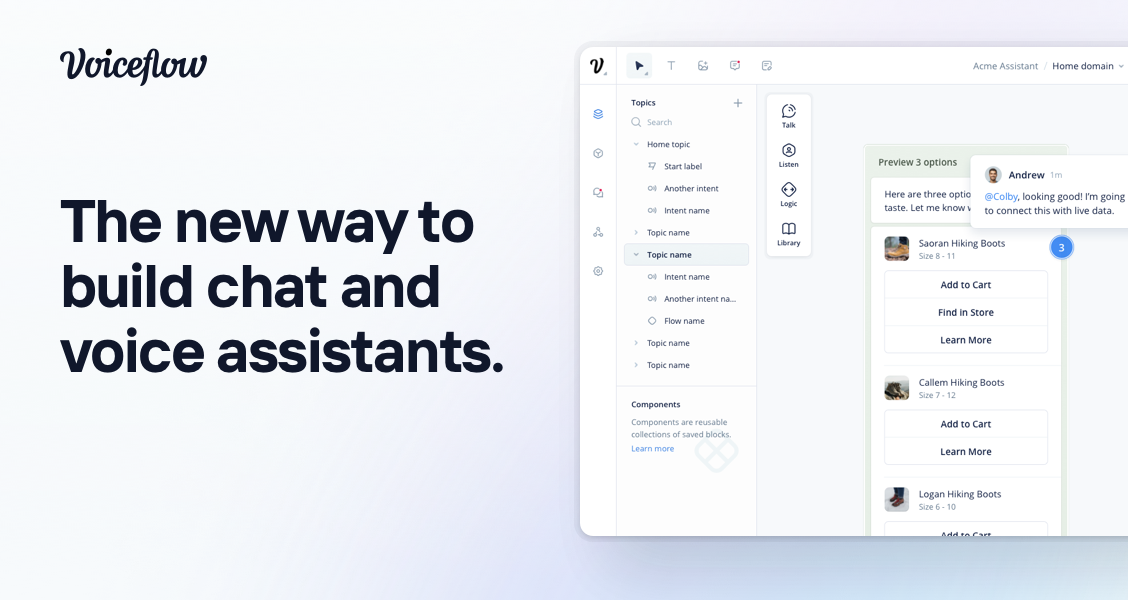The demand for conversational AI — mostly chatbots — has arguably never been higher, riding the publicity wave of systems like OpenAI’s ChatGPT. Last year, Gartner predicted that one in 10 agent-customer exchanges will be automated by 2026, an increase from the estimated 1.6% of chats that were handed off to chatbots in 2022.
Unsurprisingly, the market for tools to build conversational AI experiences is large — and growing. Future Market Insights expects that it’ll be worth $47.6 billion in 2033, up from $9.6 billion in 2023.
Case in point, Voiceflow, a platform for creating conversational AI, today announced that it raised $15 million in a funding round led by VC firm OpenView. Founder and CEO Braden Ream said that the tranche, which bring Voiceflow’s total raised to $35 million, values the startup at $105 million post-money.
“With this latest investment round, Voiceflow will amplify its commitment to product innovation,” Ream told TechCrunch in an email interview. “This includes the addition of an LLM-powered AI builder, which gives customers a place to build and deploy large language model-powered agents for customer support and more.”
Ream co-launched Voiceflow in 2019 alongside Tyler Han, Michael Hood and Andrew Lawrence. After joining forces in college to build apps for Amazon Alexa — and, subsequently, dropping out of college together — the Toronto-based trio had the idea to make a tool to create conversational agents for automating particular customer service use cases.
“Our vision was to build the largest collaborative platform to enable anyone to work together in a team to create amazing AI agents to automate anything,” Ream said. “Today, our primary focus is customer support automation for websites and in-app assistants.”
Ream describes Voiceflow as a “Figma-quality” collaborative design platform for building AI agents. To that end, teams can use Voiceflow to deploy agents powered by large language models, including — but not limited to — OpenAI’s GPT-4.

Image Credits: Voiceflow
With Voiceflow, a company can design, test and deploy an AI agent without being locked in to a particular model or technology, mixing and matching different models — including speech recognition models — to create conversational AI experiences.
“Voiceflow allows for integration with any existing natural language understanding platform or technology stack, allowing teams to supercharge their design and collaboration capabilities without costly vendor replacements or technology changes,” Ream said. “It also lets enterprise customers use any large language model, including their own, as well as popular models via APIs.”
Voiceflow, which has a workforce of around 50 people, has rivals in Google-owned Dialogflow, IBM Watson, AWS Lex and Microsoft Bot Framework, among others. That’s not to mention startups like Quiq, Yellow Messenger, Rasa and Level AI, which collectively have raised over $100 million in capital to date.
But Voiceflow has a respectably large customer base — 450 customers, including Amazon JP Morgan, The Home Depot, State Farm, Vodafone and an unnamed government agency, which combined have around 130,000 users on the platform.
“Voiceflow’s signups and usage have roughly doubled since the launch of ChatGPT in November, as the interest in conversational AI grows,” Ream said. “Voiceflow enables nontechnical and technical stakeholders to work together to collaboratively build AI agents for any use case in a safe, controlled environment. This enables enterprises to rapidly build, test and deploy large language model-powered agents for internal or external use cases faster.”















 English (US) ·
English (US) ·